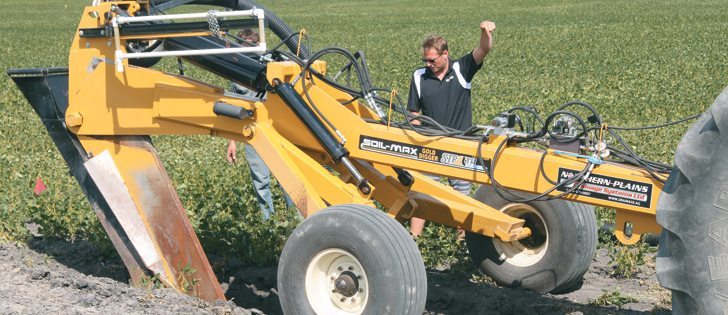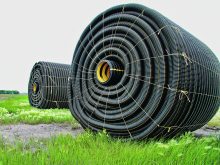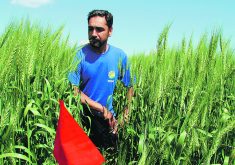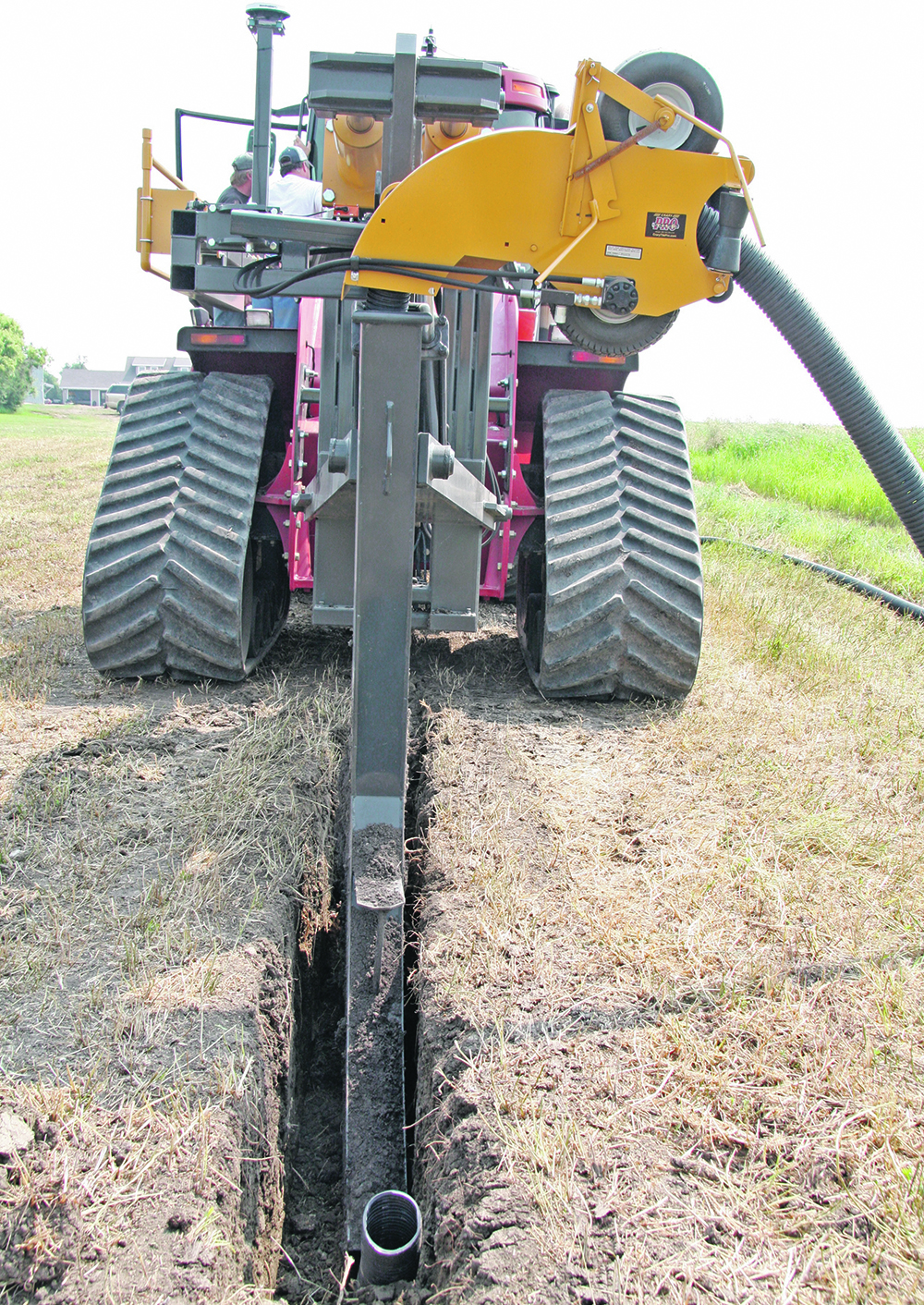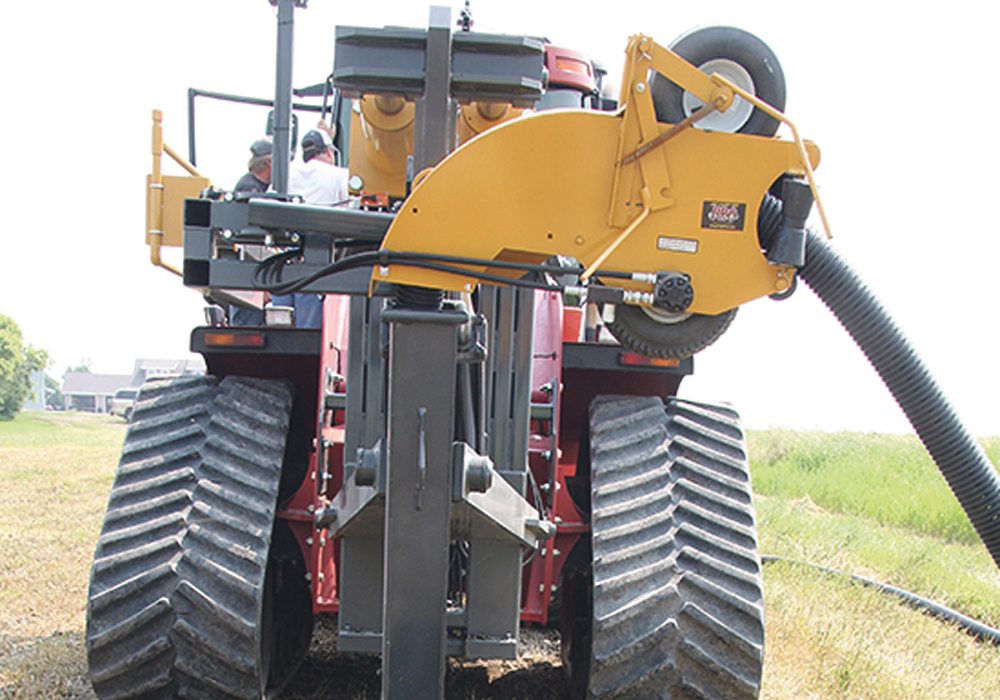Retention pond stores water | Stored water could be used for irrigation and keeps nutrients out of rivers and lakes
ELM CREEK, Man. — As he walked into his soybean field, Carl Classen couldn’t help but shake his head.
The soil was dry and cracked and the beans desperately needed moisture in the second week of August. The scene made Classen think about last fall, when he decided not to install irrigation on his farm.
Irrigation, however, remains a possibility, because Classen installed drainage tiles under his land and dug a retention pond to collect the tile water.
Classen decided to invest in tile drainage and the pond partly because his son, Joel, and son-in-law, Simon Knutson, own and operate Northern Plains Drainage Systems.
Read Also

Farming Smarter receives financial boost from Alberta government for potato research
Farming Smarter near Lethbridge got a boost to its research equipment, thanks to the Alberta government’s increase in funding for research associations.
The company provides consulting and installation services for drainage projects and sells tiling plows in Western Canada.
Besides supporting the family business, in wet years a 20-acre depression on Classen’s soybean field was inundated with water, making seeding impossible in the spring.
Instead of expanding his farm, Classen decided to invest in the productivity of his existing acreage.
“It doesn’t make sense to buy extra land if that land also has problems,” said Classen, who has tiled approximately 90 acres of land so far. “I’m going to keep on going (tiling). I think it works really well.”
The tile, or perforated pipe, under Classen’s land is extremely unusual in Manitoba’s Red River Valley, where many producers remain skeptical about subsurface drainage.
Knutson said his company hasn’t installed tile or sold any tiling plows to farmers in the valley.
“What we hear a lot (from producers) is that tile doesn’t work in heavy clay,” Knutson said at Northern Plains Drainage Systems field day, held at Classen’s farm in August. “I think there have been some government studies, maybe in the 80s … that had some conclusions that tile doesn’t work in this soil. That seems to have to stuck with quite a few growers.”
Knutson said that perception is at odds with the reality south of the border. Tiling is popular with farmers in North Dakota’s Red River Valley, where producers have installed subsurface drainage on tens of thousands of acres.
Classen may be a tiling trailblazer in Manitoba’s Red River Valley, but his neighbours remain skeptical, probably because it costs $700 to $1,000 per acre, or more, to install perforated pipe under a field.
“We get a lot of calls from (producers), saying, ‘this is something I’m really interested in, but all my neighbours think I’m crazy. I don’t want to be the first one to do it,’ ” Knutson said.
“Maybe it has something to do with land prices. South of the border they’re a lot higher.”
While business is slow, or non-existent, in the Red River Valley, Knutson said demand is high in Sask-atchewan, Alberta and western Manitoba.
“The Alberta market has really picked up: the Calgary to Edmonton corridor. So far this year that’s probably been our biggest area of interest.”
Many farmers in that region and other parts of the Prairies are buying a tiling plow and installing perforated pipe, strategically, under 20 to 40 acre depressions on their land.
“I’d like to see guys tackling whole quarter sections and buying all the pipe for that, but that’s not what we’re seeing,” Knutson said. “What we’re seeing is more targeting the problem areas (in a field).”
He said that strategy makes economic sense because the tile could alleviate spring flooding and increase the yield on a piece of cropland from zero to 50 bu. per acre.
Owning a tiling plow offers farmers the flexibility to tackle other problem areas on their land when they have the time and money. Farmers are also choosing to buy tiling plows because it’s difficult to hire tile installation contractors for a 30-acre job.
“To move that equipment out there (to Alberta or Saskatchewan), you’re looking at thousands and thousands of dollars,” Knutson said.
The tile drainage and retention pond on Classen’s farm is part of a research project evaluating the benefits of storing water on the landscape.
David Lobb, University of Manitoba soil scientist and watershed expert, said a combination of tile drainage and retention ponds may offer a range of benefits, including increased yields, irrigation opportunities and keeping crop nutrients out of lakes, rivers and streams.
“To manage water quality we must manage runoff,” said Lobb, who spoke at the field day.
Lobb said a retention pond that collects water from a section of land would likely have enough water to irrigate a quarter section of cropland.
Classen said in a growing season like this summer, when it hasn’t rained in the Red River Valley for a few weeks, applying an inch of water to his parched soybean crop would increase yields dramatically.
The water in Classen’s retention pond may not be going on his beans this summer, but he plans to use the pond in future years for irrigation.




